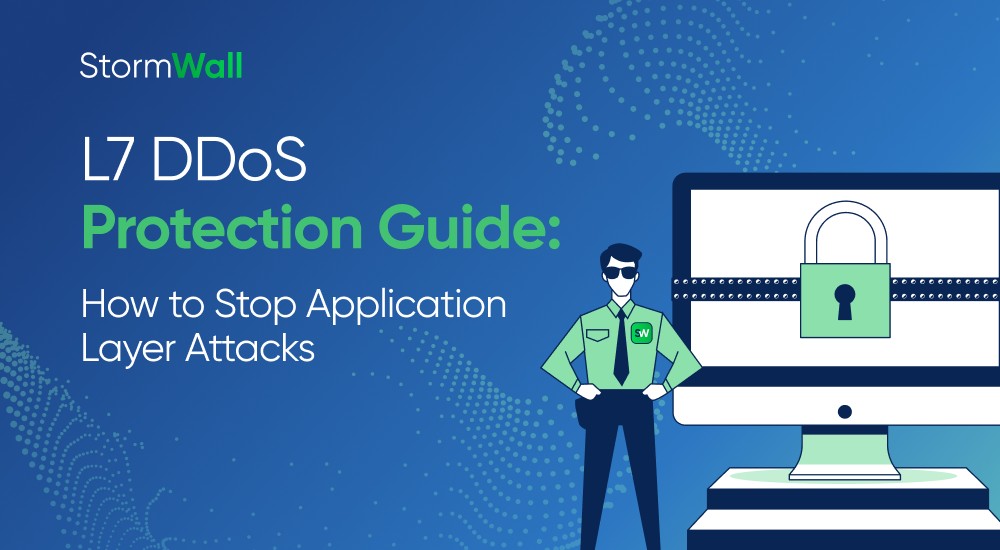Our analysts report that 90% of DDoS attacks worldwide target the application layer (L7). But what exactly are these attacks? Why are they so attractive to cybercriminals? And what solutions are most effective against them? We cover all this—and more—in the article below.

What You Need to Know About Layer 7 (L7)
In one of our recent articles, we compared the OSI and TCP/IP models and found that both highlight the Application Layer (L7) as one of the most critical components of a network. In simple terms, this layer gives users and applications access to various online services and resources. And if we dig a little deeper, it becomes clear that most online user actions take place at L7.
Some of the most common protocols operating at Layer 7 of the OSI model include HTTP(S), SMTP, FTP, and RDP. These enable everyday actions like browsing the web, connecting to a remote desktop, downloading files, sending emails, sharing media in messengers, or ordering items through marketplace apps.
In addition to protocols, many network services also run on L7. These are responsible for the smooth functioning of user processes—from sending messages and accessing databases to retrieving files from the cloud.
From a cybersecurity perspective, L7 is especially important. It handles user authentication (via credentials like usernames and passwords), generates error messages (including access denial), and is the most frequent target of DDoS attacks.
The attacker’s goal remains the same: to make the target’s website or application unavailable or cause disruptions. The logic is simple: if the number of requests exceeds what the server can handle, it can’t process them and stops responding to new users.
The popularity of L7 DDoS attacks is easy to understand. They’re more efficient and cost-effective for attackers compared to L3/L4 attacks. At the network and transport layers (L3/L4), attacks typically involve high volumes of traffic or rapid packet rates. In contrast, L7 attacks can involve much lower bandwidth, but a significantly higher number of requests, which can be just as devastating to the target system.
In many cases, attackers only need to find a single vulnerability in a site or application to launch a precise, high-impact L7 attack.
What makes things even harder is that distinguishing between legitimate and malicious traffic at L7 is extremely difficult. Bots interact with login forms, search functions, file downloads—in other words, they mimic real user behavior. That’s why effective protection against L7 DDoS attacks requires specialized solutions and deep expertise.
Reducing the Risk of L7 DDoS Attacks
The first step is to choose a solution that can analyze incoming traffic and distinguish legitimate requests from malicious ones. The second step is to ensure reliable and accurate mitigation of DDoS attacks.
One of the standard methods used for L7 protection is rate limiting—setting thresholds for how many requests can be made per second, minute, or other timeframes. However, in practice, this approach can be time-consuming and complex. To avoid blocking legitimate users, rate limits must be carefully defined for every possible type of request.
Geo-blocking, which restricts IP addresses based on geographic location, is now far less effective. There are plenty of tools that allow attackers to bypass geo-restrictions, including proxy programs, smart DNS, and VPN services. Plus, geo-blocking doesn’t help if the attack comes from IP addresses located within your own country.
To stop bots, many website owners also use CAPTCHAs—simple challenges that are easy for humans but hard for machines, like selecting images or solving basic math problems. However, bots are getting smarter, and many types of CAPTCHAs are no longer effective.
Another way to verify traffic legitimacy is through browser fingerprinting, usually performed at the web server level. Special frameworks help determine whether a request is coming from a real browser or a bot emulating one. Detecting a fake browser is often a clear sign of an automated DDoS attempt.
Finally, one of the most effective methods for stopping spam traffic is deep request analysis—inspecting request headers, payloads, and other attributes. While powerful, this method requires large-scale analysis of historical data, continuous monitoring of live traffic, and fast reaction to anomalies. These tasks are nearly impossible to perform manually and require specialized, automated DDoS protection tools.
With proper automation, it’s possible to detect and block malicious traffic within minutes—something that can make a critical difference during an attack.
When Do You Need L7 DDoS Protection?
It’s simple—start by looking at your threat model. If your website or application is business-critical, a specialized L7 DDoS protection solution is essential. And ideally, it should be a turnkey service from a provider with a proven track record of securing the online assets of other companies.
A dedicated L7 protection service already includes predefined patterns for known attack types. You don’t have to develop response algorithms yourself—experienced specialists from the provider handle everything. They configure protection rules based on the specifics of your business and the threats most relevant to you.
Another key advantage is that reliable service providers offer quality guarantees. They’re invested in your success—that’s why the most important performance indicators, like response time and percentage of blocked DDoS traffic, are clearly defined in the Service Level Agreement (SLA).
And finally, a specialized service is the best solution if you’re already under attack. With quick setup and configuration—often in just a few minutes—you can restore access to your website fast and minimize potential downtime and financial losses.

DDoS Protection for Websites
- Activate protection in 10 minutes
- 24/7 technical support




















